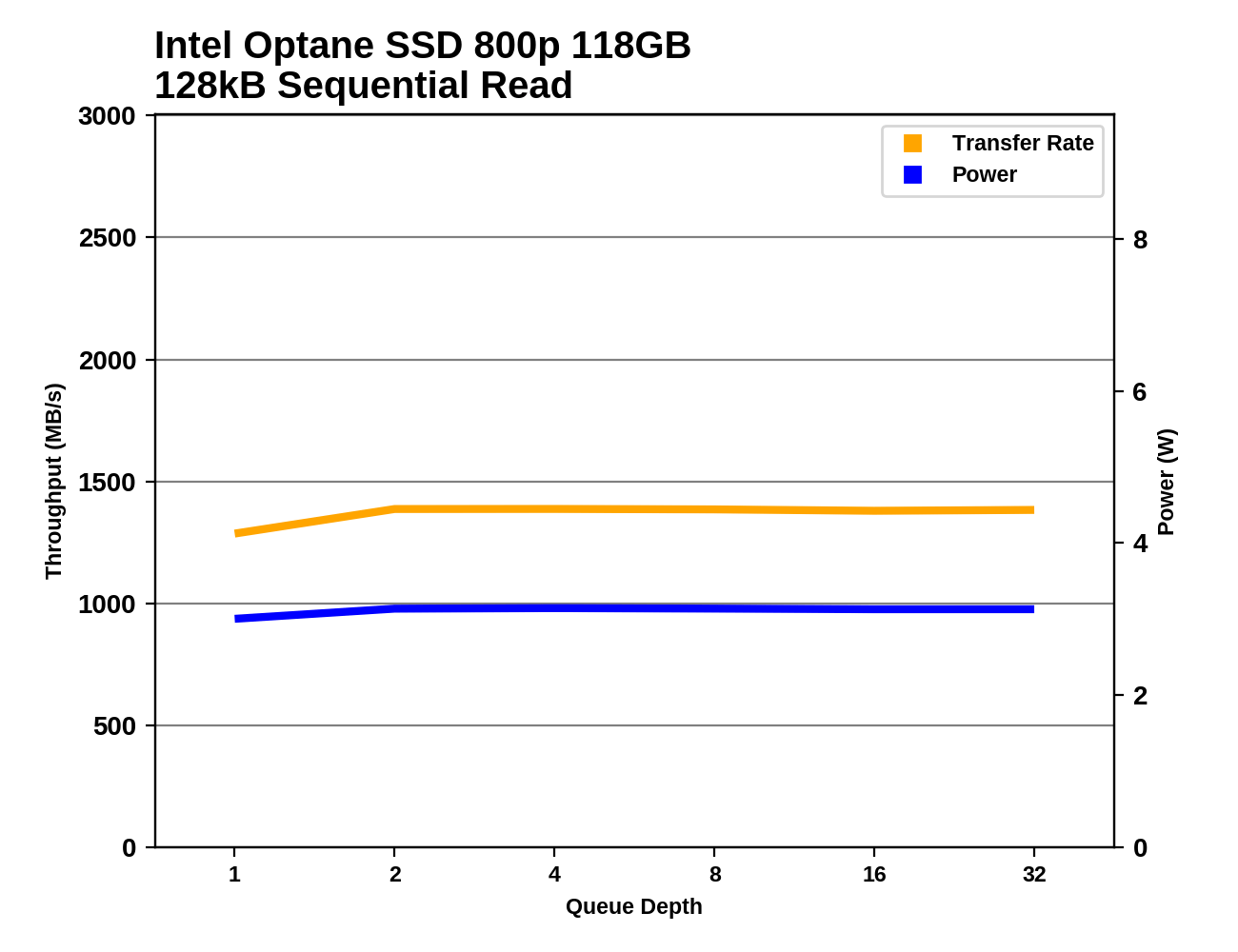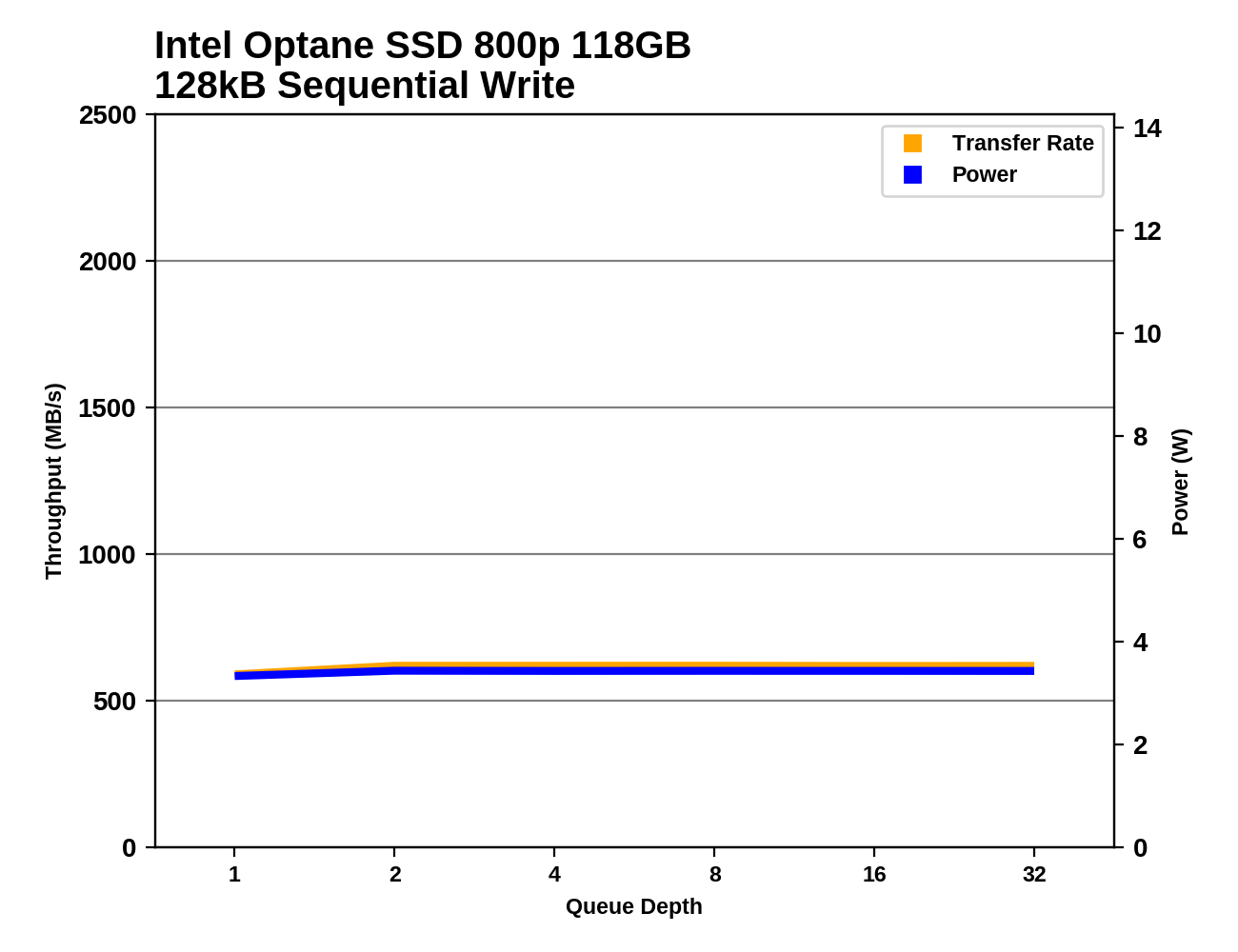The Intel Optane SSD 800p (58GB & 118GB) Review: Almost The Right Size
by Billy Tallis on March 8, 2018 5:15 PM ESTSequential Read Performance
Our first test of sequential read performance uses short bursts of 128MB, issued as 128kB operations with no queuing. The test averages performance across eight bursts for a total of 1GB of data transferred from a drive containing 16GB of data. Between each burst the drive is given enough idle time to keep the overall duty cycle at 20%.

The QD1 burst sequential read performance of the Intel Optane SSD 800p is close to their rated maximum throughput, but they are far behind the 900p and high-end Samsung drives that actually need more than two PCIe lanes.
Our test of sustained sequential reads uses queue depths from 1 to 32, with the performance and power scores computed as the average of QD1, QD2 and QD4. Each queue depth is tested for up to one minute or 32GB transferred, from a drive containing 64GB of data.

On the longer sequential read test, the Samsung NVMe SSDs fall down to the level of the Optane SSD 800p, because the flash-based SSDs are slowed down by some of the data fragmentation left over from the random write test. The Optane SSDs performed those writes as in-place modifications and thus didn't incur any fragmentation. This leaves the Samsung 960 PRO 2TB barely faster than the 800p, while the 900p runs away with its lead.

The Optane SSD 800p has the clear lead in power efficiency, as its second-tier performance comes with far lower power consumption than the top-performing 900p.
 |
|||||||||
There are no big surprises with the queue depth scaling; the 800p's sequential reads are slightly faster at QD2 than QD1, but there's no further improvement beyond that. The 800p is easily staying within its 3.75 W rated maximum power draw.
Sequential Write Performance
Our test of sequential write burst performance is structured identically to the sequential read burst performance test save for the direction of the data transfer. Each burst writes 128MB as 128kB operations issued at QD1, for a total of 1GB of data written to a drive containing 16GB of data.

The burst sequential write speed of the Intel Optane SSD 800p is no better than the low-end flash-based NVMe SSDs. Without any write caching mechanism in the controller, the fundamental nature of 3D XPoint write speeds shows through. The 900p overcomes this by using a 7-channel controller, but that design doesn't fit within the M.2 form factor.
Our test of sustained sequential writes is structured identically to our sustained sequential read test, save for the direction of the data transfers. Queue depths range from 1 to 32 and each queue depth is tested for up to one minute or 32GB, followed by up to one minute of idle time for the drive to cool off and perform garbage collection. The test is confined to a 64GB span of the drive.

The Optane SSD 800p looks better on the sustained sequential write test, as all the TLC-based SSDs run out of SLC cache and slow down dramatically, while the Optane SSDs keep delivering the exact same performance.

Despite their very different sequential write throughput, the Optane SSD 900p and 800p end up with very similar power efficiency on this test. The Samsung NVMe drives are even more efficient, but only the premium MLC-based 960 PRO has a large lead.
 |
|||||||||
Almost all of the drives show no performance scaling with increasing queue depth, as large-block sequential writes can keep all the memory channels busy with only a little bit of buffering. The 900p needs at least two 128kB writes in flight to reach full throughput.










116 Comments
View All Comments
Reflex - Thursday, March 8, 2018 - link
I'm sorry you know how many are rushing out to buy a product that isn't available yet? I don't personally expect large volumes since at the current capacities it isn't in the sweet spot for consumers in price/perf, but its offering solid performance that bests NAND in almost every consumer scenario, in some cases significantly while consuming less overall power. That's a win. As production ramps, costs will come down.And only the literacy challenged have chosen to read Intel's claims about 3DXPoint's potential as claims about its first generation products. Right now its constrained by a number of things beyond the memory itself, such as PCIe bus speed.
iter - Friday, March 9, 2018 - link
And I am sorry don't possess common sense.Of course I am not talking about how the 800p sells, only a complete idiot could take this out of my comments. I am talking about the non-existent demand for it in the enterprise, which the introduction of the 800p is another testament to.
If intel was able to sell it at high enterprise margins they wouldn't be forcing it in the consumer world where it is pointless. Intel is not keep on losing money, and as overpriced as it is even as a consumer product, it is tremendously cheaper than what they can ask for it at the enterprise market. Instead they are marketing it to frigging games... which is 100% laughable.
And of course, I don't expect anyone save for silly fanboys with rich mommies to buy it in the consumer world. because it can offer absolutely nothing for the price premium it comes at. No intelligent human being would pick a 118 gb 800p to a decent 256 gb nvme or 512 gb ssd drive. None whatsoever.
Constrained by PCIe? It doesn't even come close to that. Neither in terms of bandwidth nor latency. But believe whatever it takes to reinforce your fake worldview.
Luckz - Wednesday, April 25, 2018 - link
Is there actually a point to 256 gb NVMe though? I mean, performance of the small 960 Evo sucks balls compared to the bigger ones. Why go NVMe when you can have a nice SATA drive with much more capacity and not even much worse perf?Adramtech - Saturday, March 10, 2018 - link
iter, Lehi fabs are 100% dedicated to Xpoint and no longer NAND. They wouldn't commit billions to that if they didn't have a path outlined for improvement and scaling.patrickjp93 - Saturday, March 10, 2018 - link
Are you kidding? AWS Memcached, Lambda, and DynamoDB have their caching layers and indexing stored in Optane.eddman - Saturday, March 10, 2018 - link
We just found ddriver's long lost twin brother.Alexvrb - Saturday, March 10, 2018 - link
Cloning tech gone wrong.Reflex - Saturday, March 10, 2018 - link
It's not his twin, it's just his new account. This place had a much better community during the too brief time he was gone.patrickjp93 - Saturday, March 10, 2018 - link
3DXP is being made on the 90nm node right now. What did you expect? It's a vastly cheaper research node for something so complex.And the performance is stunningly better than everything else Samsung has EXCEPT for high Queue Depth sequential performance. All real world testing shows the 960Pro getting smashed.
Reflex - Saturday, March 10, 2018 - link
Didn't you hear the memo that because this first gen product isn't as good as the theoretical max performance discussed three years ago its all a big fail? /sarcasm